Corporate Collapses of AWA & HIH: Auditing Standards & Ethics
VerifiedAdded on 2023/04/23
|11
|3019
|219
Report
AI Summary
This report analyzes the corporate collapses of AWA and HIH, focusing on the roles of their respective auditors, DHS (Deloitte Haskins and Sells) for AWA and Arthur Anderson for HIH. It examines the auditors' contributions to the collapses, highlighting issues such as the absence of audit engagement letters, failures in audit planning, inadequate reviews, and non-detection of illegal activities. The report also discusses breaches of auditor independence and ethical behavior, including familiarity and self-interest threats. Furthermore, it explores improvements in auditing standards since these collapses and provides recommendations for preventing similar failures in the future, emphasizing the importance of auditor independence, ethical conduct, and robust audit procedures. Desklib provides access to similar solved assignments.

Running head: AUDITING
Auditing
Name of the student
Name of the university
Student ID
Author note
Auditing
Name of the student
Name of the university
Student ID
Author note
Paraphrase This Document
Need a fresh take? Get an instant paraphrase of this document with our AI Paraphraser
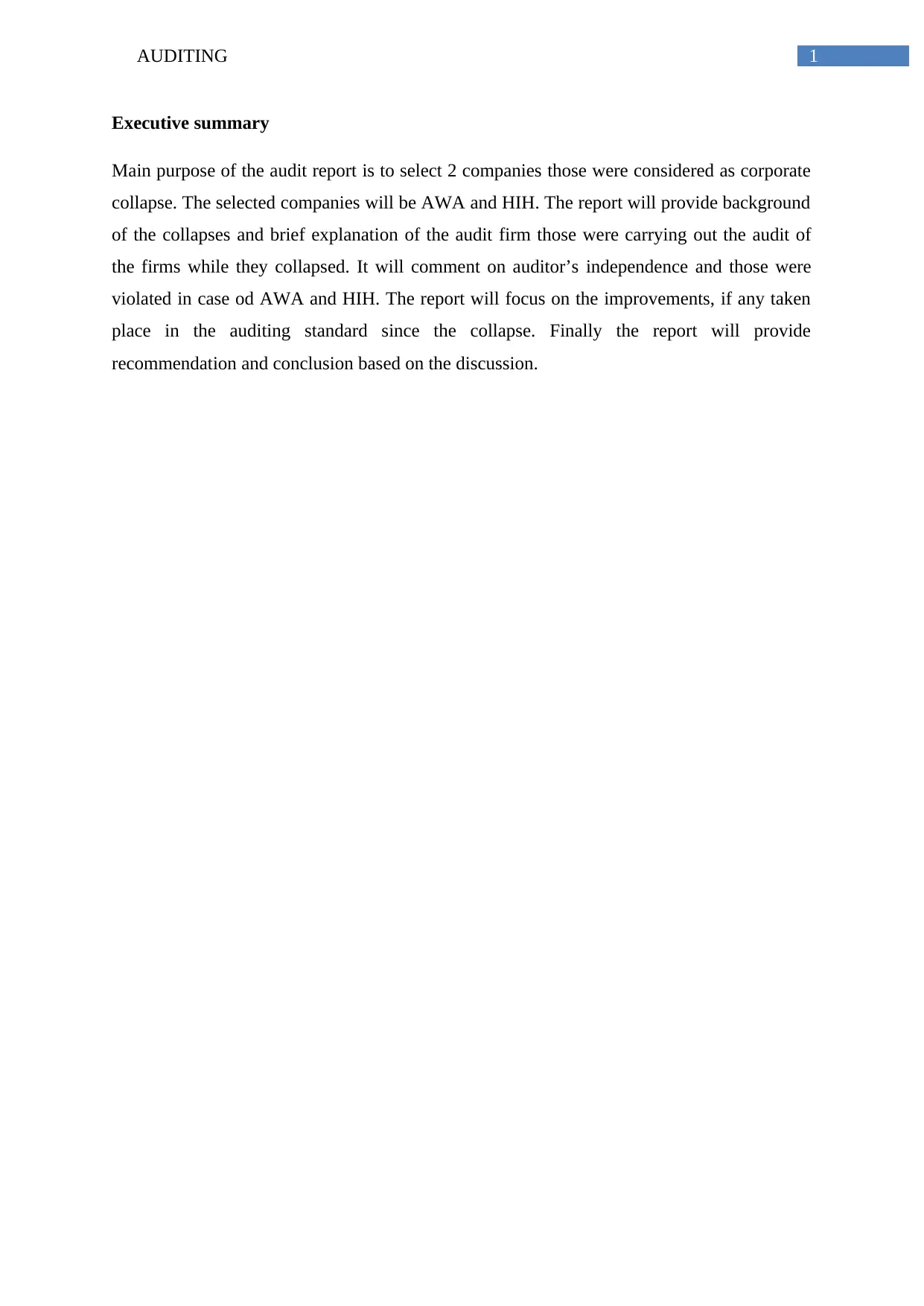
1AUDITING
Executive summary
Main purpose of the audit report is to select 2 companies those were considered as corporate
collapse. The selected companies will be AWA and HIH. The report will provide background
of the collapses and brief explanation of the audit firm those were carrying out the audit of
the firms while they collapsed. It will comment on auditor’s independence and those were
violated in case od AWA and HIH. The report will focus on the improvements, if any taken
place in the auditing standard since the collapse. Finally the report will provide
recommendation and conclusion based on the discussion.
Executive summary
Main purpose of the audit report is to select 2 companies those were considered as corporate
collapse. The selected companies will be AWA and HIH. The report will provide background
of the collapses and brief explanation of the audit firm those were carrying out the audit of
the firms while they collapsed. It will comment on auditor’s independence and those were
violated in case od AWA and HIH. The report will focus on the improvements, if any taken
place in the auditing standard since the collapse. Finally the report will provide
recommendation and conclusion based on the discussion.

2AUDITING
Table of Contents
Introduction of two collapses.....................................................................................................3
Explanation of the auditors of collapsed companies..................................................................3
Contribution of audit procedure to collapse...............................................................................4
Auditor’s independence and ethical and professional behaviour...............................................6
Improvements in auditing standards..........................................................................................7
Recommendation........................................................................................................................8
Conclusion..................................................................................................................................8
Reference....................................................................................................................................9
Table of Contents
Introduction of two collapses.....................................................................................................3
Explanation of the auditors of collapsed companies..................................................................3
Contribution of audit procedure to collapse...............................................................................4
Auditor’s independence and ethical and professional behaviour...............................................6
Improvements in auditing standards..........................................................................................7
Recommendation........................................................................................................................8
Conclusion..................................................................................................................................8
Reference....................................................................................................................................9
⊘ This is a preview!⊘
Do you want full access?
Subscribe today to unlock all pages.

Trusted by 1+ million students worldwide

3AUDITING
Introduction of two collapses
AWA case is considered as the major Australian authority on the issues surrounded
by the auditor’s negligence. The case and its appeal during 1995 was concentrated upon the
role and responsibility of auditor’s regarding detection of fraudulent activity of one of the
AWA officer, Koval with regard to the trading of foreign currency and transaction those were
undertaken in favour of AWA during November 1985 to July 1987. Negligence of the auditor
DHS while conducting the interim audit and preparing statement of profit confirmation
during 1986 which was found misleading subsequently (Awa.com.au 2019).
On the other hand the corporate collapse of the insurance company HIH is considered
as largest corporate failures in the history of Australia. Impact of the company’s failure was
widespread with new as well as continuing difficulties that were experienced by the
individual and organisations those were seeking for risk cover. Reasons behind the HIH
collapse was mismanagement of affairs of the company that was associated by lack of
attention, lack of the accountability regarding performance, poor decision-making and lack of
integrity in the internal systems (Hih.com.au 2019).
Explanation of the auditors of collapsed companies
In case of AWA the audit firm was DHS (Deloitte Haskins and Sells) while it
collapsed. DHS provides lots more than the audit services and their strength is broad
experience of more than 20 people those have well over 300 years of the work life as the
professional in advisory and audit. DHS audit partners is the public audit firm that is
authorised by Finnish audit Oversight Board. DHS offers professional services for co-
operative banks, owner managed business and public sector mainly. DHS is one of the major
players in provision of the audit service for the liquidators. Clients of DHS audit firm are
benefitted from deep specialization, extensive industry insights and experiences (Deloitte
Australia 2019).
On the other hand, in case of HIH the audit firm was Arthur Anderson while it
collapsed. Arthur Anderson started his accounting firm Anderson, DeLany & Company in the
year 1913. However, after departure of DeLany the firm altered its name to Arthur Anderson
& Company. It became the the largest consulting firm globally and was generating 40% of
the revenue from delivering the consulting business (Andersen.com 2019). However, after the
Introduction of two collapses
AWA case is considered as the major Australian authority on the issues surrounded
by the auditor’s negligence. The case and its appeal during 1995 was concentrated upon the
role and responsibility of auditor’s regarding detection of fraudulent activity of one of the
AWA officer, Koval with regard to the trading of foreign currency and transaction those were
undertaken in favour of AWA during November 1985 to July 1987. Negligence of the auditor
DHS while conducting the interim audit and preparing statement of profit confirmation
during 1986 which was found misleading subsequently (Awa.com.au 2019).
On the other hand the corporate collapse of the insurance company HIH is considered
as largest corporate failures in the history of Australia. Impact of the company’s failure was
widespread with new as well as continuing difficulties that were experienced by the
individual and organisations those were seeking for risk cover. Reasons behind the HIH
collapse was mismanagement of affairs of the company that was associated by lack of
attention, lack of the accountability regarding performance, poor decision-making and lack of
integrity in the internal systems (Hih.com.au 2019).
Explanation of the auditors of collapsed companies
In case of AWA the audit firm was DHS (Deloitte Haskins and Sells) while it
collapsed. DHS provides lots more than the audit services and their strength is broad
experience of more than 20 people those have well over 300 years of the work life as the
professional in advisory and audit. DHS audit partners is the public audit firm that is
authorised by Finnish audit Oversight Board. DHS offers professional services for co-
operative banks, owner managed business and public sector mainly. DHS is one of the major
players in provision of the audit service for the liquidators. Clients of DHS audit firm are
benefitted from deep specialization, extensive industry insights and experiences (Deloitte
Australia 2019).
On the other hand, in case of HIH the audit firm was Arthur Anderson while it
collapsed. Arthur Anderson started his accounting firm Anderson, DeLany & Company in the
year 1913. However, after departure of DeLany the firm altered its name to Arthur Anderson
& Company. It became the the largest consulting firm globally and was generating 40% of
the revenue from delivering the consulting business (Andersen.com 2019). However, after the
Paraphrase This Document
Need a fresh take? Get an instant paraphrase of this document with our AI Paraphraser
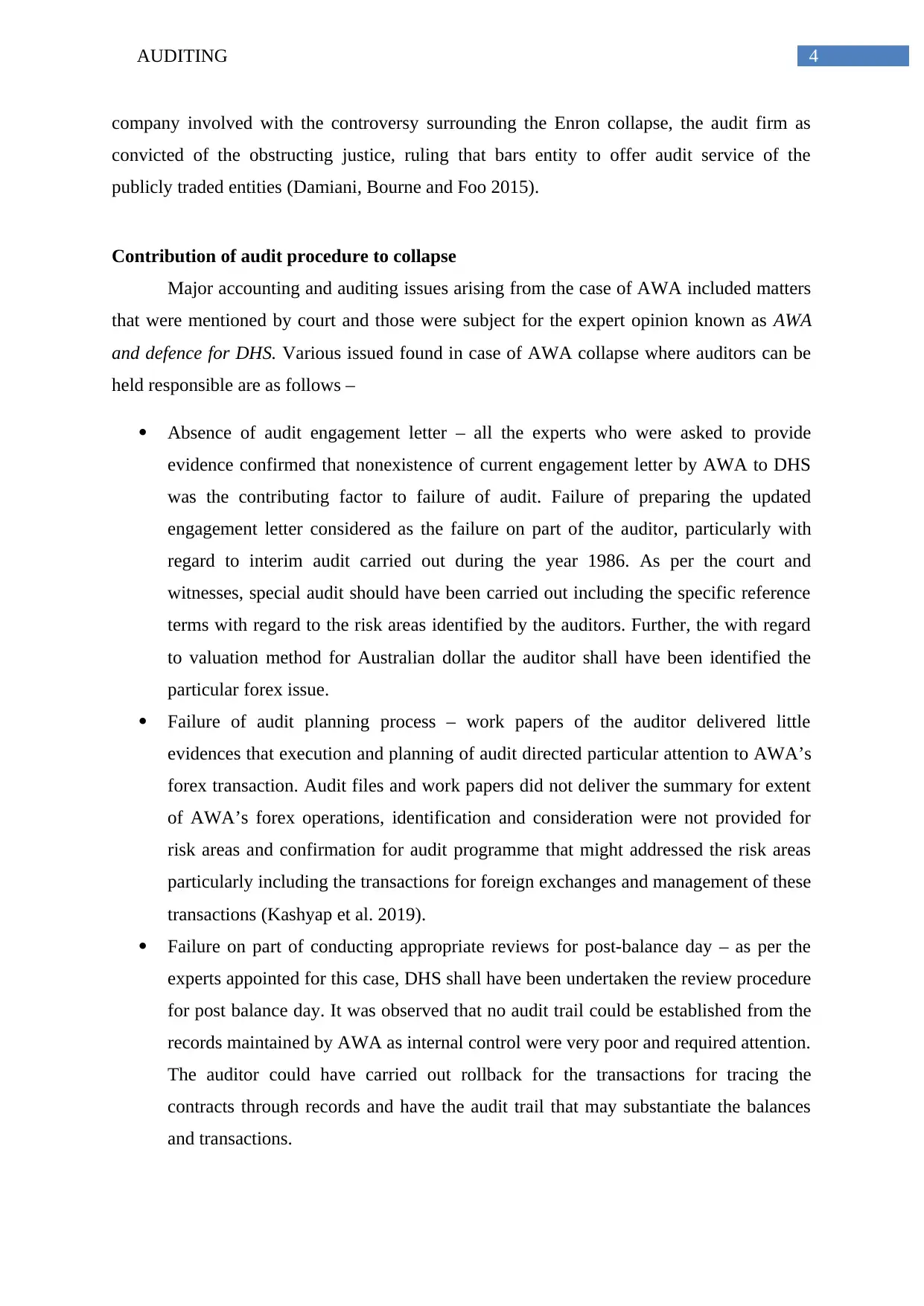
4AUDITING
company involved with the controversy surrounding the Enron collapse, the audit firm as
convicted of the obstructing justice, ruling that bars entity to offer audit service of the
publicly traded entities (Damiani, Bourne and Foo 2015).
Contribution of audit procedure to collapse
Major accounting and auditing issues arising from the case of AWA included matters
that were mentioned by court and those were subject for the expert opinion known as AWA
and defence for DHS. Various issued found in case of AWA collapse where auditors can be
held responsible are as follows –
Absence of audit engagement letter – all the experts who were asked to provide
evidence confirmed that nonexistence of current engagement letter by AWA to DHS
was the contributing factor to failure of audit. Failure of preparing the updated
engagement letter considered as the failure on part of the auditor, particularly with
regard to interim audit carried out during the year 1986. As per the court and
witnesses, special audit should have been carried out including the specific reference
terms with regard to the risk areas identified by the auditors. Further, the with regard
to valuation method for Australian dollar the auditor shall have been identified the
particular forex issue.
Failure of audit planning process – work papers of the auditor delivered little
evidences that execution and planning of audit directed particular attention to AWA’s
forex transaction. Audit files and work papers did not deliver the summary for extent
of AWA’s forex operations, identification and consideration were not provided for
risk areas and confirmation for audit programme that might addressed the risk areas
particularly including the transactions for foreign exchanges and management of these
transactions (Kashyap et al. 2019).
Failure on part of conducting appropriate reviews for post-balance day – as per the
experts appointed for this case, DHS shall have been undertaken the review procedure
for post balance day. It was observed that no audit trail could be established from the
records maintained by AWA as internal control were very poor and required attention.
The auditor could have carried out rollback for the transactions for tracing the
contracts through records and have the audit trail that may substantiate the balances
and transactions.
company involved with the controversy surrounding the Enron collapse, the audit firm as
convicted of the obstructing justice, ruling that bars entity to offer audit service of the
publicly traded entities (Damiani, Bourne and Foo 2015).
Contribution of audit procedure to collapse
Major accounting and auditing issues arising from the case of AWA included matters
that were mentioned by court and those were subject for the expert opinion known as AWA
and defence for DHS. Various issued found in case of AWA collapse where auditors can be
held responsible are as follows –
Absence of audit engagement letter – all the experts who were asked to provide
evidence confirmed that nonexistence of current engagement letter by AWA to DHS
was the contributing factor to failure of audit. Failure of preparing the updated
engagement letter considered as the failure on part of the auditor, particularly with
regard to interim audit carried out during the year 1986. As per the court and
witnesses, special audit should have been carried out including the specific reference
terms with regard to the risk areas identified by the auditors. Further, the with regard
to valuation method for Australian dollar the auditor shall have been identified the
particular forex issue.
Failure of audit planning process – work papers of the auditor delivered little
evidences that execution and planning of audit directed particular attention to AWA’s
forex transaction. Audit files and work papers did not deliver the summary for extent
of AWA’s forex operations, identification and consideration were not provided for
risk areas and confirmation for audit programme that might addressed the risk areas
particularly including the transactions for foreign exchanges and management of these
transactions (Kashyap et al. 2019).
Failure on part of conducting appropriate reviews for post-balance day – as per the
experts appointed for this case, DHS shall have been undertaken the review procedure
for post balance day. It was observed that no audit trail could be established from the
records maintained by AWA as internal control were very poor and required attention.
The auditor could have carried out rollback for the transactions for tracing the
contracts through records and have the audit trail that may substantiate the balances
and transactions.
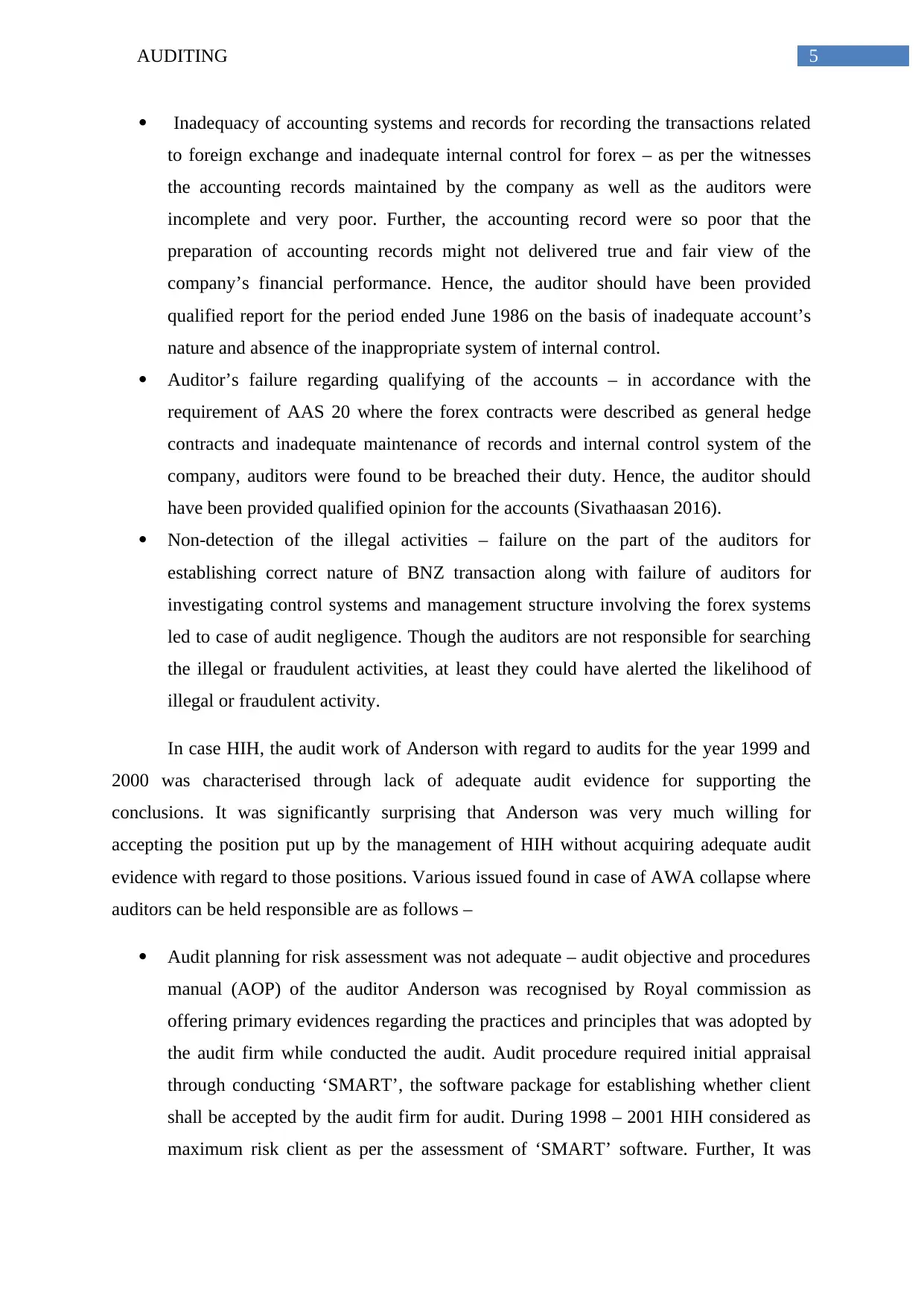
5AUDITING
Inadequacy of accounting systems and records for recording the transactions related
to foreign exchange and inadequate internal control for forex – as per the witnesses
the accounting records maintained by the company as well as the auditors were
incomplete and very poor. Further, the accounting record were so poor that the
preparation of accounting records might not delivered true and fair view of the
company’s financial performance. Hence, the auditor should have been provided
qualified report for the period ended June 1986 on the basis of inadequate account’s
nature and absence of the inappropriate system of internal control.
Auditor’s failure regarding qualifying of the accounts – in accordance with the
requirement of AAS 20 where the forex contracts were described as general hedge
contracts and inadequate maintenance of records and internal control system of the
company, auditors were found to be breached their duty. Hence, the auditor should
have been provided qualified opinion for the accounts (Sivathaasan 2016).
Non-detection of the illegal activities – failure on the part of the auditors for
establishing correct nature of BNZ transaction along with failure of auditors for
investigating control systems and management structure involving the forex systems
led to case of audit negligence. Though the auditors are not responsible for searching
the illegal or fraudulent activities, at least they could have alerted the likelihood of
illegal or fraudulent activity.
In case HIH, the audit work of Anderson with regard to audits for the year 1999 and
2000 was characterised through lack of adequate audit evidence for supporting the
conclusions. It was significantly surprising that Anderson was very much willing for
accepting the position put up by the management of HIH without acquiring adequate audit
evidence with regard to those positions. Various issued found in case of AWA collapse where
auditors can be held responsible are as follows –
Audit planning for risk assessment was not adequate – audit objective and procedures
manual (AOP) of the auditor Anderson was recognised by Royal commission as
offering primary evidences regarding the practices and principles that was adopted by
the audit firm while conducted the audit. Audit procedure required initial appraisal
through conducting ‘SMART’, the software package for establishing whether client
shall be accepted by the audit firm for audit. During 1998 – 2001 HIH considered as
maximum risk client as per the assessment of ‘SMART’ software. Further, It was
Inadequacy of accounting systems and records for recording the transactions related
to foreign exchange and inadequate internal control for forex – as per the witnesses
the accounting records maintained by the company as well as the auditors were
incomplete and very poor. Further, the accounting record were so poor that the
preparation of accounting records might not delivered true and fair view of the
company’s financial performance. Hence, the auditor should have been provided
qualified report for the period ended June 1986 on the basis of inadequate account’s
nature and absence of the inappropriate system of internal control.
Auditor’s failure regarding qualifying of the accounts – in accordance with the
requirement of AAS 20 where the forex contracts were described as general hedge
contracts and inadequate maintenance of records and internal control system of the
company, auditors were found to be breached their duty. Hence, the auditor should
have been provided qualified opinion for the accounts (Sivathaasan 2016).
Non-detection of the illegal activities – failure on the part of the auditors for
establishing correct nature of BNZ transaction along with failure of auditors for
investigating control systems and management structure involving the forex systems
led to case of audit negligence. Though the auditors are not responsible for searching
the illegal or fraudulent activities, at least they could have alerted the likelihood of
illegal or fraudulent activity.
In case HIH, the audit work of Anderson with regard to audits for the year 1999 and
2000 was characterised through lack of adequate audit evidence for supporting the
conclusions. It was significantly surprising that Anderson was very much willing for
accepting the position put up by the management of HIH without acquiring adequate audit
evidence with regard to those positions. Various issued found in case of AWA collapse where
auditors can be held responsible are as follows –
Audit planning for risk assessment was not adequate – audit objective and procedures
manual (AOP) of the auditor Anderson was recognised by Royal commission as
offering primary evidences regarding the practices and principles that was adopted by
the audit firm while conducted the audit. Audit procedure required initial appraisal
through conducting ‘SMART’, the software package for establishing whether client
shall be accepted by the audit firm for audit. During 1998 – 2001 HIH considered as
maximum risk client as per the assessment of ‘SMART’ software. Further, It was
⊘ This is a preview!⊘
Do you want full access?
Subscribe today to unlock all pages.

Trusted by 1+ million students worldwide
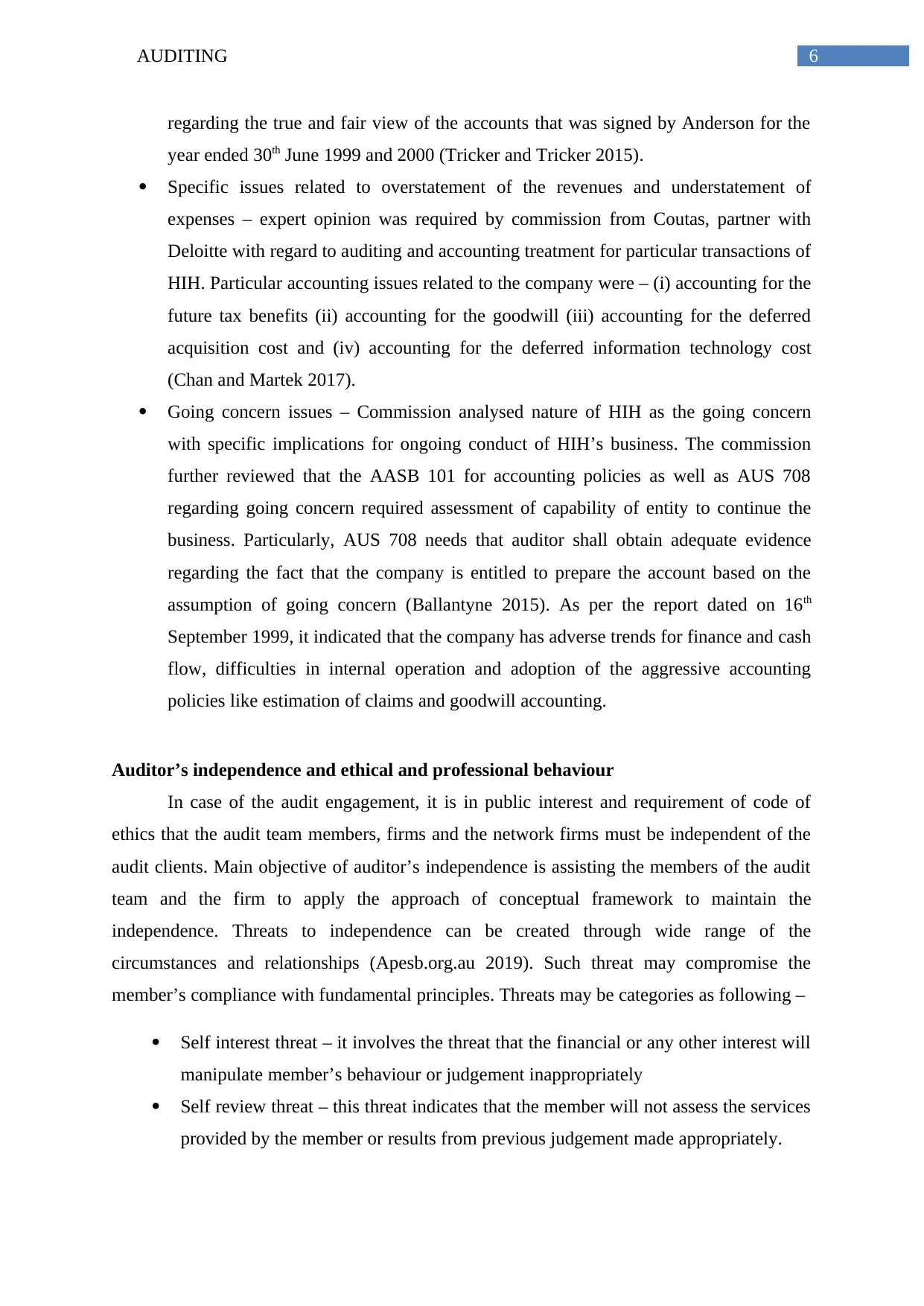
6AUDITING
regarding the true and fair view of the accounts that was signed by Anderson for the
year ended 30th June 1999 and 2000 (Tricker and Tricker 2015).
Specific issues related to overstatement of the revenues and understatement of
expenses – expert opinion was required by commission from Coutas, partner with
Deloitte with regard to auditing and accounting treatment for particular transactions of
HIH. Particular accounting issues related to the company were – (i) accounting for the
future tax benefits (ii) accounting for the goodwill (iii) accounting for the deferred
acquisition cost and (iv) accounting for the deferred information technology cost
(Chan and Martek 2017).
Going concern issues – Commission analysed nature of HIH as the going concern
with specific implications for ongoing conduct of HIH’s business. The commission
further reviewed that the AASB 101 for accounting policies as well as AUS 708
regarding going concern required assessment of capability of entity to continue the
business. Particularly, AUS 708 needs that auditor shall obtain adequate evidence
regarding the fact that the company is entitled to prepare the account based on the
assumption of going concern (Ballantyne 2015). As per the report dated on 16th
September 1999, it indicated that the company has adverse trends for finance and cash
flow, difficulties in internal operation and adoption of the aggressive accounting
policies like estimation of claims and goodwill accounting.
Auditor’s independence and ethical and professional behaviour
In case of the audit engagement, it is in public interest and requirement of code of
ethics that the audit team members, firms and the network firms must be independent of the
audit clients. Main objective of auditor’s independence is assisting the members of the audit
team and the firm to apply the approach of conceptual framework to maintain the
independence. Threats to independence can be created through wide range of the
circumstances and relationships (Apesb.org.au 2019). Such threat may compromise the
member’s compliance with fundamental principles. Threats may be categories as following –
Self interest threat – it involves the threat that the financial or any other interest will
manipulate member’s behaviour or judgement inappropriately
Self review threat – this threat indicates that the member will not assess the services
provided by the member or results from previous judgement made appropriately.
regarding the true and fair view of the accounts that was signed by Anderson for the
year ended 30th June 1999 and 2000 (Tricker and Tricker 2015).
Specific issues related to overstatement of the revenues and understatement of
expenses – expert opinion was required by commission from Coutas, partner with
Deloitte with regard to auditing and accounting treatment for particular transactions of
HIH. Particular accounting issues related to the company were – (i) accounting for the
future tax benefits (ii) accounting for the goodwill (iii) accounting for the deferred
acquisition cost and (iv) accounting for the deferred information technology cost
(Chan and Martek 2017).
Going concern issues – Commission analysed nature of HIH as the going concern
with specific implications for ongoing conduct of HIH’s business. The commission
further reviewed that the AASB 101 for accounting policies as well as AUS 708
regarding going concern required assessment of capability of entity to continue the
business. Particularly, AUS 708 needs that auditor shall obtain adequate evidence
regarding the fact that the company is entitled to prepare the account based on the
assumption of going concern (Ballantyne 2015). As per the report dated on 16th
September 1999, it indicated that the company has adverse trends for finance and cash
flow, difficulties in internal operation and adoption of the aggressive accounting
policies like estimation of claims and goodwill accounting.
Auditor’s independence and ethical and professional behaviour
In case of the audit engagement, it is in public interest and requirement of code of
ethics that the audit team members, firms and the network firms must be independent of the
audit clients. Main objective of auditor’s independence is assisting the members of the audit
team and the firm to apply the approach of conceptual framework to maintain the
independence. Threats to independence can be created through wide range of the
circumstances and relationships (Apesb.org.au 2019). Such threat may compromise the
member’s compliance with fundamental principles. Threats may be categories as following –
Self interest threat – it involves the threat that the financial or any other interest will
manipulate member’s behaviour or judgement inappropriately
Self review threat – this threat indicates that the member will not assess the services
provided by the member or results from previous judgement made appropriately.
Paraphrase This Document
Need a fresh take? Get an instant paraphrase of this document with our AI Paraphraser
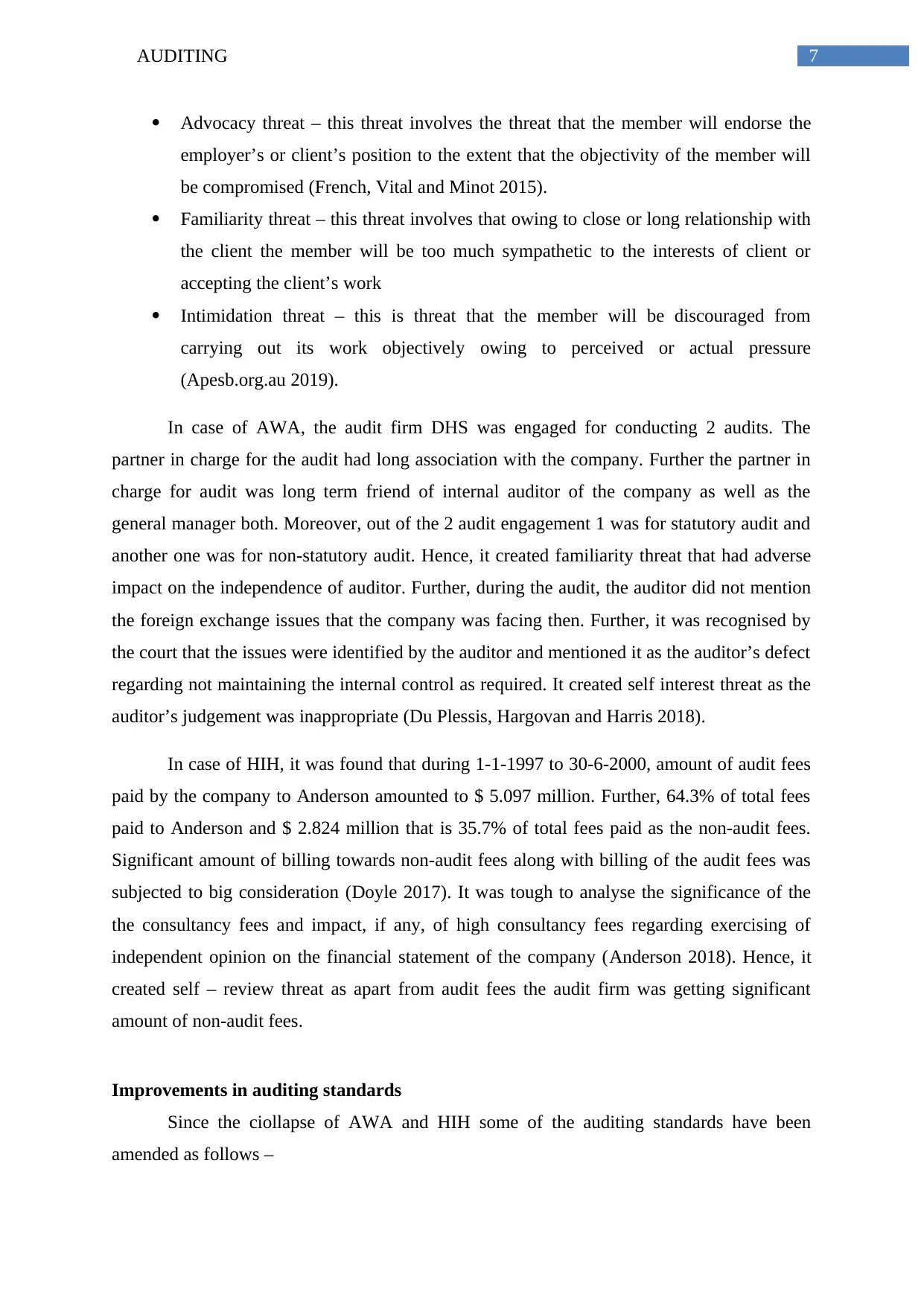
7AUDITING
Advocacy threat – this threat involves the threat that the member will endorse the
employer’s or client’s position to the extent that the objectivity of the member will
be compromised (French, Vital and Minot 2015).
Familiarity threat – this threat involves that owing to close or long relationship with
the client the member will be too much sympathetic to the interests of client or
accepting the client’s work
Intimidation threat – this is threat that the member will be discouraged from
carrying out its work objectively owing to perceived or actual pressure
(Apesb.org.au 2019).
In case of AWA, the audit firm DHS was engaged for conducting 2 audits. The
partner in charge for the audit had long association with the company. Further the partner in
charge for audit was long term friend of internal auditor of the company as well as the
general manager both. Moreover, out of the 2 audit engagement 1 was for statutory audit and
another one was for non-statutory audit. Hence, it created familiarity threat that had adverse
impact on the independence of auditor. Further, during the audit, the auditor did not mention
the foreign exchange issues that the company was facing then. Further, it was recognised by
the court that the issues were identified by the auditor and mentioned it as the auditor’s defect
regarding not maintaining the internal control as required. It created self interest threat as the
auditor’s judgement was inappropriate (Du Plessis, Hargovan and Harris 2018).
In case of HIH, it was found that during 1-1-1997 to 30-6-2000, amount of audit fees
paid by the company to Anderson amounted to $ 5.097 million. Further, 64.3% of total fees
paid to Anderson and $ 2.824 million that is 35.7% of total fees paid as the non-audit fees.
Significant amount of billing towards non-audit fees along with billing of the audit fees was
subjected to big consideration (Doyle 2017). It was tough to analyse the significance of the
the consultancy fees and impact, if any, of high consultancy fees regarding exercising of
independent opinion on the financial statement of the company (Anderson 2018). Hence, it
created self – review threat as apart from audit fees the audit firm was getting significant
amount of non-audit fees.
Improvements in auditing standards
Since the ciollapse of AWA and HIH some of the auditing standards have been
amended as follows –
Advocacy threat – this threat involves the threat that the member will endorse the
employer’s or client’s position to the extent that the objectivity of the member will
be compromised (French, Vital and Minot 2015).
Familiarity threat – this threat involves that owing to close or long relationship with
the client the member will be too much sympathetic to the interests of client or
accepting the client’s work
Intimidation threat – this is threat that the member will be discouraged from
carrying out its work objectively owing to perceived or actual pressure
(Apesb.org.au 2019).
In case of AWA, the audit firm DHS was engaged for conducting 2 audits. The
partner in charge for the audit had long association with the company. Further the partner in
charge for audit was long term friend of internal auditor of the company as well as the
general manager both. Moreover, out of the 2 audit engagement 1 was for statutory audit and
another one was for non-statutory audit. Hence, it created familiarity threat that had adverse
impact on the independence of auditor. Further, during the audit, the auditor did not mention
the foreign exchange issues that the company was facing then. Further, it was recognised by
the court that the issues were identified by the auditor and mentioned it as the auditor’s defect
regarding not maintaining the internal control as required. It created self interest threat as the
auditor’s judgement was inappropriate (Du Plessis, Hargovan and Harris 2018).
In case of HIH, it was found that during 1-1-1997 to 30-6-2000, amount of audit fees
paid by the company to Anderson amounted to $ 5.097 million. Further, 64.3% of total fees
paid to Anderson and $ 2.824 million that is 35.7% of total fees paid as the non-audit fees.
Significant amount of billing towards non-audit fees along with billing of the audit fees was
subjected to big consideration (Doyle 2017). It was tough to analyse the significance of the
the consultancy fees and impact, if any, of high consultancy fees regarding exercising of
independent opinion on the financial statement of the company (Anderson 2018). Hence, it
created self – review threat as apart from audit fees the audit firm was getting significant
amount of non-audit fees.
Improvements in auditing standards
Since the ciollapse of AWA and HIH some of the auditing standards have been
amended as follows –
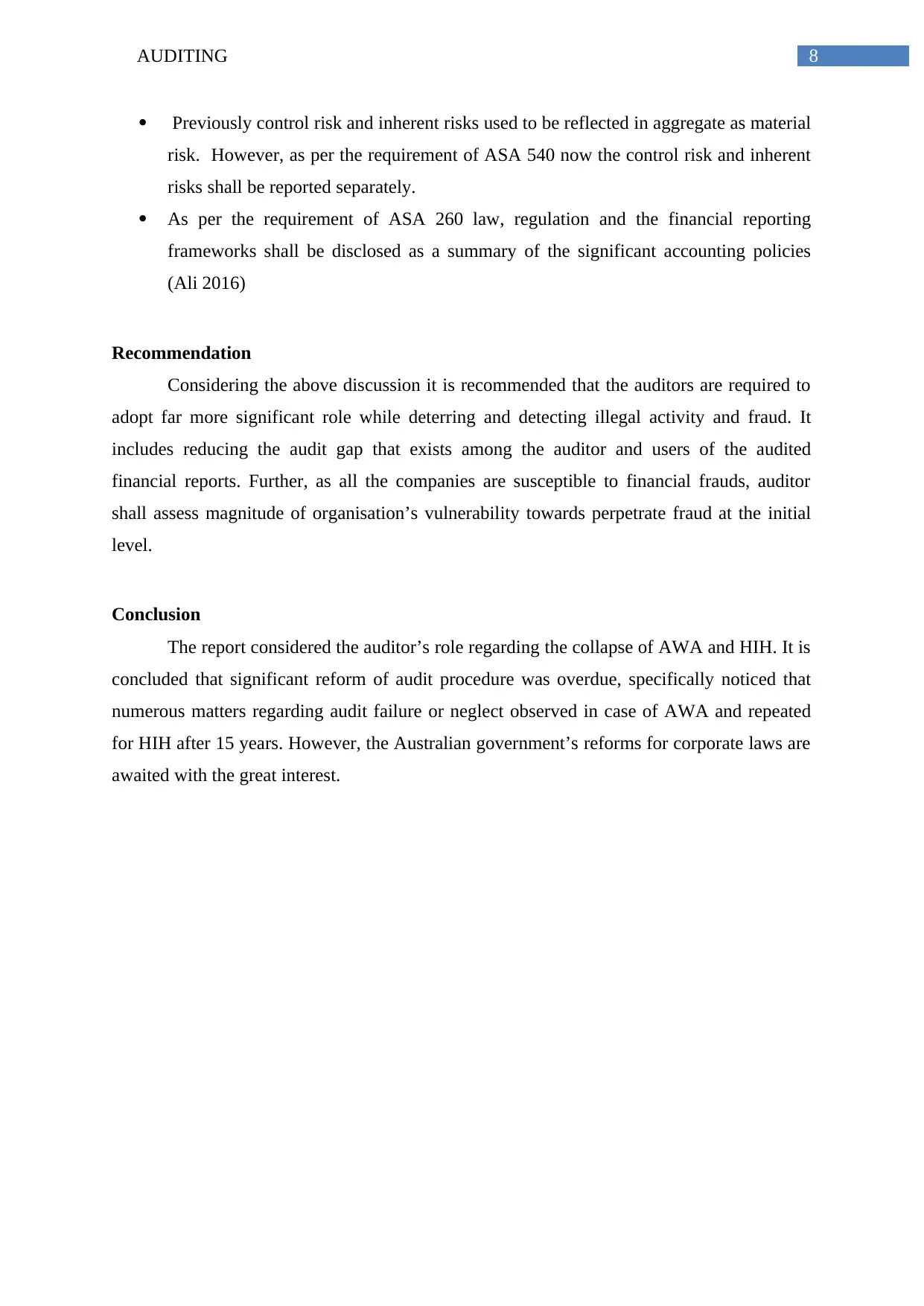
8AUDITING
Previously control risk and inherent risks used to be reflected in aggregate as material
risk. However, as per the requirement of ASA 540 now the control risk and inherent
risks shall be reported separately.
As per the requirement of ASA 260 law, regulation and the financial reporting
frameworks shall be disclosed as a summary of the significant accounting policies
(Ali 2016)
Recommendation
Considering the above discussion it is recommended that the auditors are required to
adopt far more significant role while deterring and detecting illegal activity and fraud. It
includes reducing the audit gap that exists among the auditor and users of the audited
financial reports. Further, as all the companies are susceptible to financial frauds, auditor
shall assess magnitude of organisation’s vulnerability towards perpetrate fraud at the initial
level.
Conclusion
The report considered the auditor’s role regarding the collapse of AWA and HIH. It is
concluded that significant reform of audit procedure was overdue, specifically noticed that
numerous matters regarding audit failure or neglect observed in case of AWA and repeated
for HIH after 15 years. However, the Australian government’s reforms for corporate laws are
awaited with the great interest.
Previously control risk and inherent risks used to be reflected in aggregate as material
risk. However, as per the requirement of ASA 540 now the control risk and inherent
risks shall be reported separately.
As per the requirement of ASA 260 law, regulation and the financial reporting
frameworks shall be disclosed as a summary of the significant accounting policies
(Ali 2016)
Recommendation
Considering the above discussion it is recommended that the auditors are required to
adopt far more significant role while deterring and detecting illegal activity and fraud. It
includes reducing the audit gap that exists among the auditor and users of the audited
financial reports. Further, as all the companies are susceptible to financial frauds, auditor
shall assess magnitude of organisation’s vulnerability towards perpetrate fraud at the initial
level.
Conclusion
The report considered the auditor’s role regarding the collapse of AWA and HIH. It is
concluded that significant reform of audit procedure was overdue, specifically noticed that
numerous matters regarding audit failure or neglect observed in case of AWA and repeated
for HIH after 15 years. However, the Australian government’s reforms for corporate laws are
awaited with the great interest.
⊘ This is a preview!⊘
Do you want full access?
Subscribe today to unlock all pages.

Trusted by 1+ million students worldwide
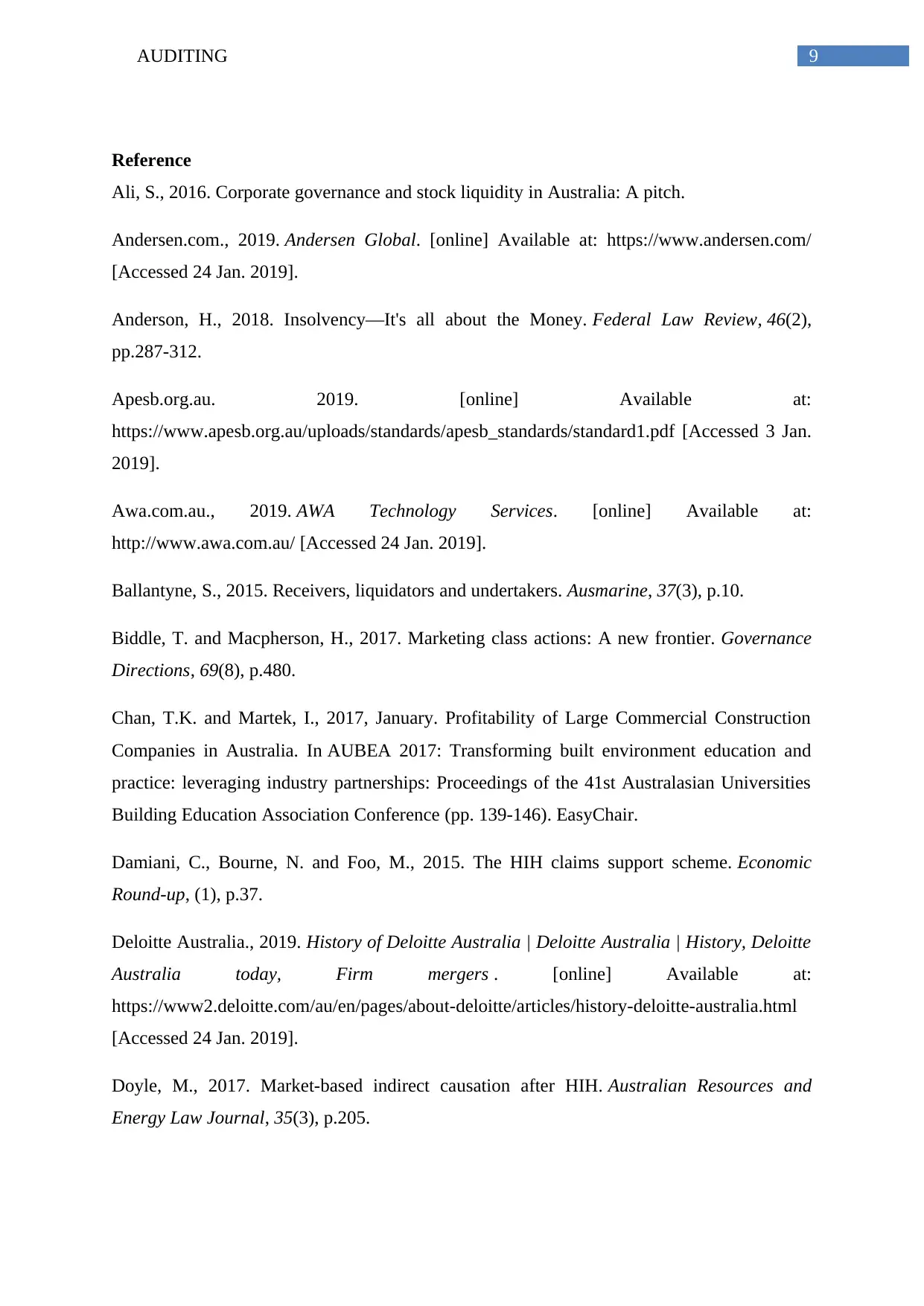
9AUDITING
Reference
Ali, S., 2016. Corporate governance and stock liquidity in Australia: A pitch.
Andersen.com., 2019. Andersen Global. [online] Available at: https://www.andersen.com/
[Accessed 24 Jan. 2019].
Anderson, H., 2018. Insolvency—It's all about the Money. Federal Law Review, 46(2),
pp.287-312.
Apesb.org.au. 2019. [online] Available at:
https://www.apesb.org.au/uploads/standards/apesb_standards/standard1.pdf [Accessed 3 Jan.
2019].
Awa.com.au., 2019. AWA Technology Services. [online] Available at:
http://www.awa.com.au/ [Accessed 24 Jan. 2019].
Ballantyne, S., 2015. Receivers, liquidators and undertakers. Ausmarine, 37(3), p.10.
Biddle, T. and Macpherson, H., 2017. Marketing class actions: A new frontier. Governance
Directions, 69(8), p.480.
Chan, T.K. and Martek, I., 2017, January. Profitability of Large Commercial Construction
Companies in Australia. In AUBEA 2017: Transforming built environment education and
practice: leveraging industry partnerships: Proceedings of the 41st Australasian Universities
Building Education Association Conference (pp. 139-146). EasyChair.
Damiani, C., Bourne, N. and Foo, M., 2015. The HIH claims support scheme. Economic
Round-up, (1), p.37.
Deloitte Australia., 2019. History of Deloitte Australia | Deloitte Australia | History, Deloitte
Australia today, Firm mergers . [online] Available at:
https://www2.deloitte.com/au/en/pages/about-deloitte/articles/history-deloitte-australia.html
[Accessed 24 Jan. 2019].
Doyle, M., 2017. Market-based indirect causation after HIH. Australian Resources and
Energy Law Journal, 35(3), p.205.
Reference
Ali, S., 2016. Corporate governance and stock liquidity in Australia: A pitch.
Andersen.com., 2019. Andersen Global. [online] Available at: https://www.andersen.com/
[Accessed 24 Jan. 2019].
Anderson, H., 2018. Insolvency—It's all about the Money. Federal Law Review, 46(2),
pp.287-312.
Apesb.org.au. 2019. [online] Available at:
https://www.apesb.org.au/uploads/standards/apesb_standards/standard1.pdf [Accessed 3 Jan.
2019].
Awa.com.au., 2019. AWA Technology Services. [online] Available at:
http://www.awa.com.au/ [Accessed 24 Jan. 2019].
Ballantyne, S., 2015. Receivers, liquidators and undertakers. Ausmarine, 37(3), p.10.
Biddle, T. and Macpherson, H., 2017. Marketing class actions: A new frontier. Governance
Directions, 69(8), p.480.
Chan, T.K. and Martek, I., 2017, January. Profitability of Large Commercial Construction
Companies in Australia. In AUBEA 2017: Transforming built environment education and
practice: leveraging industry partnerships: Proceedings of the 41st Australasian Universities
Building Education Association Conference (pp. 139-146). EasyChair.
Damiani, C., Bourne, N. and Foo, M., 2015. The HIH claims support scheme. Economic
Round-up, (1), p.37.
Deloitte Australia., 2019. History of Deloitte Australia | Deloitte Australia | History, Deloitte
Australia today, Firm mergers . [online] Available at:
https://www2.deloitte.com/au/en/pages/about-deloitte/articles/history-deloitte-australia.html
[Accessed 24 Jan. 2019].
Doyle, M., 2017. Market-based indirect causation after HIH. Australian Resources and
Energy Law Journal, 35(3), p.205.
Paraphrase This Document
Need a fresh take? Get an instant paraphrase of this document with our AI Paraphraser
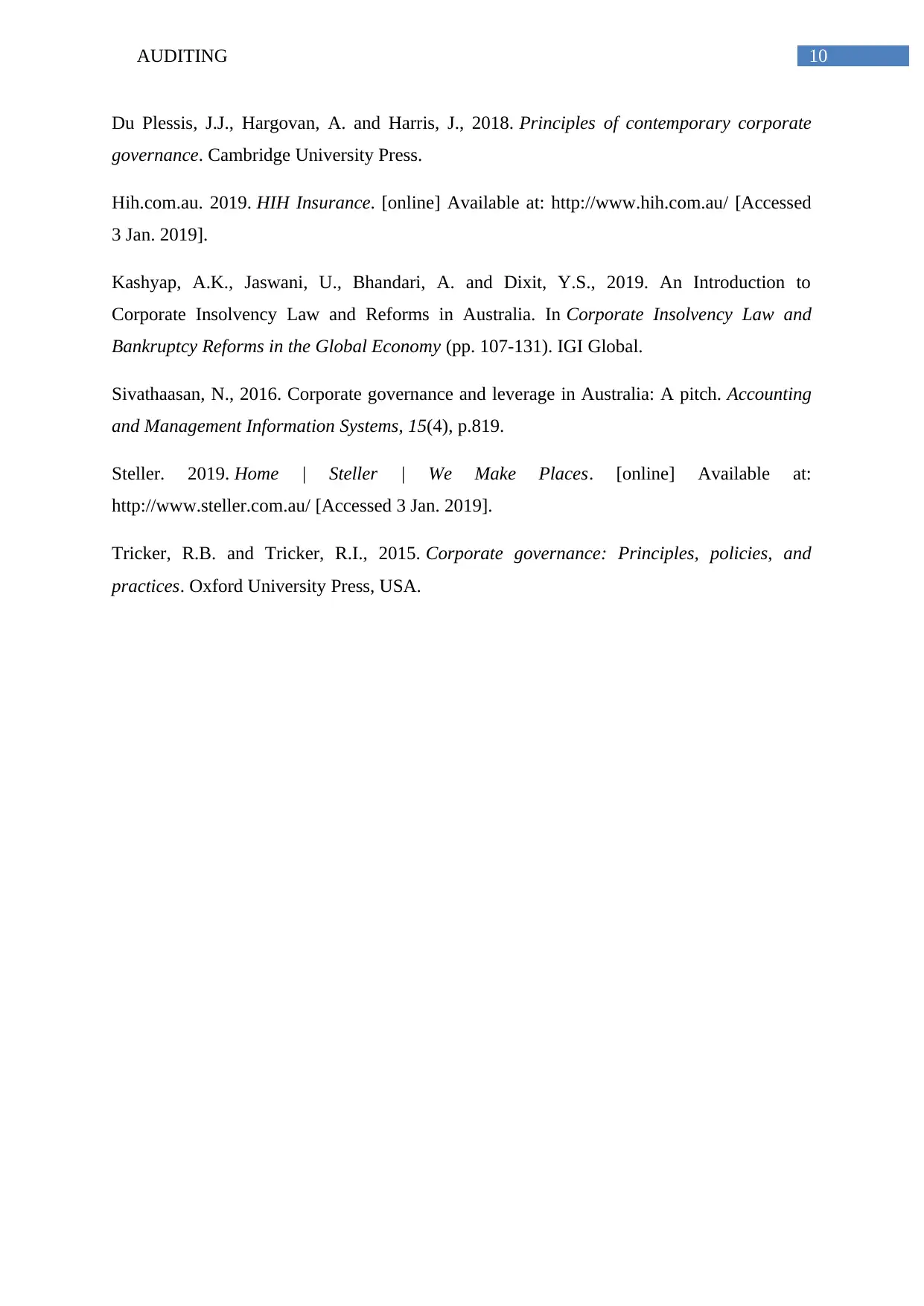
10AUDITING
Du Plessis, J.J., Hargovan, A. and Harris, J., 2018. Principles of contemporary corporate
governance. Cambridge University Press.
Hih.com.au. 2019. HIH Insurance. [online] Available at: http://www.hih.com.au/ [Accessed
3 Jan. 2019].
Kashyap, A.K., Jaswani, U., Bhandari, A. and Dixit, Y.S., 2019. An Introduction to
Corporate Insolvency Law and Reforms in Australia. In Corporate Insolvency Law and
Bankruptcy Reforms in the Global Economy (pp. 107-131). IGI Global.
Sivathaasan, N., 2016. Corporate governance and leverage in Australia: A pitch. Accounting
and Management Information Systems, 15(4), p.819.
Steller. 2019. Home | Steller | We Make Places. [online] Available at:
http://www.steller.com.au/ [Accessed 3 Jan. 2019].
Tricker, R.B. and Tricker, R.I., 2015. Corporate governance: Principles, policies, and
practices. Oxford University Press, USA.
Du Plessis, J.J., Hargovan, A. and Harris, J., 2018. Principles of contemporary corporate
governance. Cambridge University Press.
Hih.com.au. 2019. HIH Insurance. [online] Available at: http://www.hih.com.au/ [Accessed
3 Jan. 2019].
Kashyap, A.K., Jaswani, U., Bhandari, A. and Dixit, Y.S., 2019. An Introduction to
Corporate Insolvency Law and Reforms in Australia. In Corporate Insolvency Law and
Bankruptcy Reforms in the Global Economy (pp. 107-131). IGI Global.
Sivathaasan, N., 2016. Corporate governance and leverage in Australia: A pitch. Accounting
and Management Information Systems, 15(4), p.819.
Steller. 2019. Home | Steller | We Make Places. [online] Available at:
http://www.steller.com.au/ [Accessed 3 Jan. 2019].
Tricker, R.B. and Tricker, R.I., 2015. Corporate governance: Principles, policies, and
practices. Oxford University Press, USA.
1 out of 11
Related Documents
Your All-in-One AI-Powered Toolkit for Academic Success.
+13062052269
info@desklib.com
Available 24*7 on WhatsApp / Email
![[object Object]](/_next/static/media/star-bottom.7253800d.svg)
Unlock your academic potential
Copyright © 2020–2025 A2Z Services. All Rights Reserved. Developed and managed by ZUCOL.





